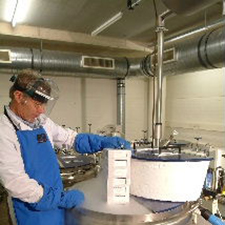Page content
Working with hazardous substances can be done safely at your umc if you follow the guidelines. Guidelines are available from the government and the NFU (Dutch Federation of University Medical Centers). In addition, each umc has its own additional policy based on local laws and regulations. The aim of all this is that you can work safely in a safe workplace. You also have your own responsibility when it comes to knowledge of hazardous substances, wearing personal protective equipment and a safe working method. Your occupational health and safety advisor (arboadviseur) can help you with this. Below some basic knowledge about hazardous substances.
What does the government do
The government makes laws about what hazardous substances are, how they should be classified, how they should be packaged and transported and so on. There are global government regulations for working safely and healthily with hazardous substances. See What does the government do. The exact interpretation of this has been left to employers and employees.
What are hazardous substances
In the Working Conditions Decree (Arbobesluit), the government has defined what it considers hazardous substances in relation to work: substances or mixtures to which workers are or may be exposed in the course of work which, by reason of the properties of the substances or the conditions under which they occur, may constitute a risk to safety or health.
How to identify dangerous substances
Hazardous substances can be recognized by the pictograms and hazard phrases on the label. The pictograms and hazard phrases (H phrases) meet the criteria described in the CLP Regulation 1272/2008/EC. Sometimes you can still come across jars with old labels with the obsolete orange hazard symbols and R phrases. This classification has not been used since 2015. Dispose of these jars: the hazard classification no longer corresponds to the current criteria according to CLP. The substance can be more harmful to health than the label indicates. In addition, the contents may have been affected by moisture and oxygen from the air.
The overview of the classification according to CLP can be found at: Safety data sheets, hazard pictograms, labels, H and P phrases. A safety data sheet (MSDS) contains all the information about each hazardous substance used in a umc. You can consult this information via the intranet at the NFU Database Hazardous Substances. Medication can also pose risks, even without warning labels. You can read about this at Working safely with medication.
What does your umc do and what can you do yourself

All umcs have collectively established determined how they want to work safely and healthily with hazardous substances. This is called a health and safety catalogue (arbocatalogus). The website Dokterhoe.nl is an elaboration of those agreements. This website contains guidelines for handling hazardous substances covering everything from purchase, transport, registration, storage, safe working methods to waste management. In addition, the umcs jointly established the NFU Hazardous Substances Database which contains validated safety information on more than 6,000 hazardous substances. Furthermore, the umcs are working on good practices that are also can be found on this site. Watch: Videos: useful tips from colleagues.
Because working with hazardous substances involves risks, you and your umc will take measures to limit occupational exposure and the risk of an accident as much as possible. The STOP strategy applies here. This roughly means: do not work with hazardous substances, or work as little as possible. If necessary, your umc will first take technical and organizational measures and then your umc will provide personal protective equipment that you wear. And before you start working with a hazardous substance, always study the H phrases and P phrases first.
